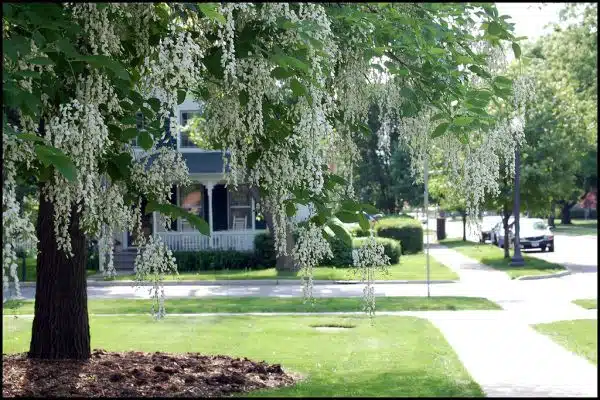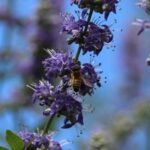The Yellowwood tree, also known as Cladrastis kentukea, is a deciduous tree native to the southeastern United States. This elegant tree species is highly valued for its lustrous foliage and clusters of fragrant white flowers that bloom in late spring or early summer. The Yellowwood tree can grow up to 50 feet tall and has a broad, spreading canopy that provides ample shade and shelter for wildlife.
In this article, we will explore the essential plant care practices and growing tips for the Yellowwood tree. From soil requirements to pruning techniques, we will cover everything you need to know to keep your Yellowwood tree healthy and thriving. Whether you are a seasoned horticulturalist or a novice gardener, this comprehensive guide will equip you with the knowledge and skills necessary to cultivate a beautiful and productive Yellowwood tree in your garden or landscape.
Overview Of The Yellowwood Tree
The Yellowwood tree, also known as Cladrastis lutea or Virgilia, is a deciduous species that belongs to the pea family. It is native to the southeastern United States and can grow up to 50 feet tall. The tree bears attractive white flowers in early June that are both fragrant and showy.
The historical significance of the Yellowwood tree can be traced back to Native American culture, where it was used for medicinal purposes. The bark of the tree was boiled to make a tea that was believed to cure fever and dysentery. Today, the plant is still used in traditional medicine for its antioxidant properties, which have been shown to reduce inflammation and promote heart health.
Aside from its uses in medicine, the Yellowwood tree is also popular in landscaping due to its beautiful appearance. Its dense foliage provides ample shade during summer months, making it an excellent choice for parks and residential areas. In addition, because of its deep root system, this species is highly resistant to drought and soil erosion. Understanding the climate and soil requirements necessary for growing healthy Yellowwood trees is key to maintaining their beauty and longevity.
Climate And Soil Requirements
The Yellowwood tree is an attractive and versatile plant that can thrive in a variety of locations. However, the best locations for planting Yellowwood trees are areas with full sun exposure and well-drained soil. This type of tree prefers to grow in places where it can have plenty of space to spread out, so be sure to give it enough room when planting.
In terms of soil conditions, Yellowwood trees prefer slightly acidic to neutral soil with a pH level between 6.0 and 7.0. The ideal soil should also be rich in organic matter, which helps to promote healthy root growth and overall plant health. If your soil is not naturally rich in organic matter, consider adding compost or other organic materials to improve its quality.
To ensure that your Yellowwood tree thrives, it is important to provide it with adequate water and fertilizer. While this type of tree can tolerate some drought conditions once established, it still requires regular watering during dry periods. Additionally, fertilization is necessary for optimal growth and development. Consider using a slow-release fertilizer specifically designed for trees or shrubs, applied according to the manufacturer’s instructions.
Moving forward into the next section about watering and fertilization techniques, it is crucial to understand how much water and fertilizer your Yellowwood tree needs to flourish. By properly caring for your plant in these ways, you will help ensure that it grows strong and healthy over time.
Watering And Fertilization
Back in the day, yellowwood trees were considered to be one of the most beautiful and valuable trees due to their durable wood that was used for a variety of purposes. Today, these trees are cherished mainly for their aesthetic appeal and the shade they provide. When it comes to growing and caring for yellowwood trees, it is essential to understand that watering frequency is crucial in maintaining healthy growth.
Yellowwood trees require moderate watering during summer months, which means they should receive water every two to three weeks. However, if the weather is hot and dry or if you are experiencing a drought season, then watering should be increased slightly. One thing to note is that overwatering yellowwood trees can lead to root rot, so it’s essential not to water too frequently.
Fertilizing yellowwood trees helps them maintain proper growth and remain healthy throughout the year. The best time to fertilize your tree is during early spring before new growth begins. The type of fertilizer needed will depend on soil quality and overall tree health. A balanced fertilizer with equal amounts of nitrogen, phosphorus, and potassium may work well for most cases, but soil testing can determine what specific nutrients your tree may need.
Sunlight And Shade Preferences
Sun exposure and shade tolerance are crucial factors to consider when caring for a yellowwood tree. This tree thrives in full sun, which means it requires at least 6 hours of direct sunlight per day to grow and develop properly. However, it can also tolerate partial shade, which makes it a versatile choice for landscaping purposes.
When planting a yellowwood tree, it is essential to choose the right location that provides adequate sun exposure. A location that receives too little sunlight can cause the tree to grow weak and spindly, while too much sunlight can lead to leaf scorch and other problems. It is best to plant the tree in an area with well-draining soil and ample space, away from competing plants.
Yellowwood trees have moderate shade tolerance, which means they can grow in partially shaded areas without being negatively impacted. However, if you want your yellowwood tree to thrive, it is best to plant it in a location that receives plenty of direct sunlight. This will ensure that the tree grows strong and healthy, producing beautiful blooms each year.
When choosing the right location for your yellowwood tree, keep in mind its sun exposure needs and shade tolerance levels. By providing adequate sunlight and avoiding overly shaded areas, you can help ensure that your tree grows healthy and strong for years to come. In the next section, we’ll explore some additional tips for choosing the perfect spot for your new yellowwood tree.
Choosing The Right Location
As the sun sets on the topic of sunlight and shade preferences for yellowwood trees, it’s time to delve into selecting the right location for your tree. Choosing a suitable spot is crucial to ensure your tree thrives and reaches its full potential. Before planting, site preparation is essential. This involves clearing any debris or vegetation that may be in the way and ensuring there is adequate space for the root system to grow.
Once you’ve cleared the area, soil testing should be carried out to determine the acidity level and nutrient content of your soil. Yellowwoods grow best in soils with a pH between 6.0-7.5, which is slightly acidic to neutral. If necessary, soil amendments can be added to adjust pH levels and improve nutrient deficiencies. A well-draining soil is also important to prevent waterlogging around the roots.
When choosing a location for your yellowwood tree, consider factors such as available sunlight, moisture levels, and wind exposure. Select an area that receives at least six hours of direct sunlight daily and has good air circulation to reduce the risk of fungal diseases. Avoid planting near structures or other large trees that may shade or compete for resources with your yellowwood tree. With proper site preparation and soil testing, you can create an optimal environment for growth and set your yellowwood tree up for success in its new home.
As you prepare to plant your yellowwood tree, keep in mind that proper site selection and soil preparation are key factors in ensuring its health and longevity. With careful planning and attention to detail, you can provide an ideal growing environment that will allow your tree to flourish for years to come. In the next section, we’ll take a closer look at how to plant your yellowwood tree for best results.
Planting Your Yellowwood Tree
When planting your yellowwood tree, there are a few key tips to keep in mind to ensure its success. First and foremost, it is important to choose the right location. Yellowwood trees prefer full sun or partial shade and well-draining soil. It is also important to consider the tree’s ultimate size when selecting a location.
Before planting, it is crucial to prepare the soil properly. This includes removing any weeds or grass from the planting area and breaking up compacted soil with a shovel or tiller. Adding organic matter such as compost or aged manure can also improve soil quality and help retain moisture.
Once the soil is prepared, it’s time to plant! Dig a hole that is slightly larger than the root ball of your yellowwood tree and gently place it into the hole. Make sure the top of the root ball is level with the ground surface. Backfill with soil, tamping down lightly as you go to remove any air pockets. Water thoroughly after planting and continue to water regularly for several weeks until your tree becomes established.
Moving on to mulching and weed control, there are several important considerations when caring for your yellowwood tree. Mulching around the base of the tree can help conserve moisture in the soil, suppress weed growth, and regulate soil temperature. It is best to use organic mulch such as wood chips or shredded leaves, applied 2-3 inches deep around the base of your tree. Weed control can be achieved through regular hand weeding or by using an herbicide specifically labeled for use around trees. Remember to always follow label instructions carefully when using any type of chemical control around plants.
Mulching And Weed Control
Mulching and Weed Control: A Paradoxical Solution
When it comes to yellowwood tree care, it’s essential to consider mulching and weed control. While these practices seem paradoxical, they are necessary for the optimal growth of your plant. Organic mulching is an excellent way to protect the roots from temperature fluctuations, retain moisture in the soil, and prevent weeds from sprouting. Contrary to popular belief, weed control doesn’t necessarily mean resorting to herbicides or chemicals. Herbicide-free weed control techniques like hand weeding or using a hoe are not only safe for the environment but also contribute to the overall health of your garden.
Organic mulch serves as a natural insulator that prevents soil erosion and keeps the roots moist during dry spells. The best time to mulch your yellowwood tree is in the early spring or fall when the soil is moist but not waterlogged. Avoid piling too much mulch around the trunk as it can lead to rotting or attract pests. Instead, spread a layer of 2-4 inches of organic matter such as leaves, grass clippings, straw or wood chips around the base of your tree.
Weed control is crucial in maintaining healthy plants as weeds compete with trees for nutrients and sunlight. Hand weeding is an effective method for removing small weeds while using a hoe can help loosen up compacted soil and prevent new growth. It’s important to remove weeds before they produce seeds; otherwise, you’ll be battling more weeds next season. By incorporating organic mulching and herbicide-free weed control into your yellowwood tree care routine, you’ll be able to promote optimal growth while ensuring a safe environment for all living organisms.
As we’ve seen earlier, regular pruning is essential in promoting healthy growth patterns for your yellowwood tree. In our next section, we’ll explore some pruning techniques that will help you maintain an aesthetically pleasing shape while keeping your tree healthy and strong.
Pruning Techniques For Optimal Growth
Branch trimming is an essential aspect of yellowwood tree care. Pruning can help the plant grow healthier and more robust, while also ensuring that it has an aesthetically pleasing shape. The primary goal of pruning is to remove dead or diseased branches, as well as any crossing or rubbing limbs.
There are various shaping methods available for yellowwood trees, including natural shaping, formal shaping, and informal shaping. Natural shaping involves minimal pruning to maintain the tree’s natural form. Formal shaping requires precise cuts to create a defined shape, such as a cone or pyramid. Informal shaping is less structured than formal shaping but still involves removing specific branches for aesthetic purposes.
The cutting frequency and timing will depend on the desired outcome and the tree’s age. Younger trees require more frequent pruning to establish their shape and structure, while mature trees need less frequent maintenance. Pruning should be done during the dormant season when growth is minimal to reduce stress on the plant. However, diseased or damaged branches should be removed immediately regardless of the time of year to prevent further damage. Proper branch trimming and shaping methods can ensure optimal growth for yellowwood trees while enhancing their beauty in any landscape design.
As with all plants, disease and pest management are crucial aspects of yellowwood tree care. It is essential to monitor the tree regularly for signs of disease or insect infestations so that prompt action can be taken before significant damage occurs. In the next section, we will discuss common diseases and pests that affect yellowwood trees and how best to manage them effectively without causing harm to other beneficial organisms in your garden ecosystem.
Disease And Pest Management
What measures can be taken to protect yellowwood trees from pests and diseases? One of the most effective ways is to prevent them from occurring in the first place. This can be achieved by providing optimal growing conditions, including adequate light, soil nutrition, and water. It’s also important to prune the tree regularly to remove any dead or diseased branches, as well as to maintain good air circulation.
Despite our best efforts, pests and diseases may still find their way to yellowwood trees. When this happens, it’s important to take action quickly before they cause irreversible damage. Natural remedies can be used as an alternative to chemical pesticides. For example, neem oil is a natural insecticide that can control a wide range of pests without harming beneficial insects like bees and butterflies. Other options include garlic spray, mineral oil, and soap-based solutions.
If natural remedies fail or if the infestation is severe, pesticide alternatives may need to be considered. However, it’s important to use these with caution as they can harm beneficial insects and pollute the environment. Choose a pesticide that targets only the specific pest or disease affecting your tree and follow the instructions carefully. Always wear protective clothing when applying pesticides and avoid spraying when pollinators are active.
Protection against pests and diseases is essential for maintaining healthy yellowwood trees. By providing optimal growing conditions and using natural remedies or pesticide alternatives when necessary, you can help prevent damage caused by these threats. In the next section, we will discuss propagation methods for yellowwood trees so that you can enjoy their beauty in your own garden or landscape.
Propagation Methods
Propagation techniques for the yellowwood tree are relatively easy, and there are several methods to choose from. One option is to propagate using seeds, which can be collected from the tree during the fall season. After collecting the seeds, they should be soaked in water for 24 hours before being planted in a mixture of sand and peat moss. Be sure to maintain adequate moisture levels during germination.
Another propagation method is through cuttings taken from mature branches. Cuttings should be taken during the late summer months and should be at least six inches in length. The bottom end of the cutting should be dipped in rooting hormone powder before being placed into a well-draining soil mix. It’s important to keep the soil moist and maintain high humidity levels until root development occurs.
Nursery care for young yellowwood trees involves providing them with adequate sunlight, water, and nutrients. Seedlings should be kept in a warm environment with indirect sunlight until their first set of true leaves appear. At this point, they can be transplanted into larger containers or directly into the ground if outdoor conditions are favorable. Cuttings require similar care but should remain in their original container until roots have developed enough to support new growth.
Growing your own yellowwood tree from propagation can be a rewarding experience that allows you to observe its growth from an early stage of development. Once established, these trees are hardy and low-maintenance additions to any landscape design. In the subsequent section about yellowwood tree varieties, we will explore some of the most popular cultivars available on the market today.
Yellowwood Tree Varieties
Having learned about the different methods of propagating yellowwood trees, it is now time to delve into the various cultivars available for this species. The yellowwood tree (Cladrastis kentukea) has a few cultivars that have been developed over the years, each with its unique features and characteristics. These cultivars differ in size, growth rate, and flower color, among other attributes.
One of the most popular yellowwood tree cultivars is ‘Perkin’s Pink,’ which features pink flowers instead of the typical white flowers seen on most yellowwood trees. This variety also tends to be smaller in size than other yellowwood tree cultivars and has a moderate growth rate. Another notable cultivar is ‘Rosea,’ which produces rosy-pink flowers during springtime and has a somewhat slower growth rate than other varieties.
If you are interested in planting a yellowwood tree in your landscape, it is essential to choose a cultivar that suits your specific needs. Consider factors such as the expected size of the tree at maturity, growth rate, flowering period, and fall foliage color when making your selection. With so many options available, you are sure to find a yellowwood tree cultivar that will thrive in your garden or yard!
As we move onto discussing the role of yellowwood trees in landscaping, it is worth noting that different varieties may be better suited for certain uses than others. For example, smaller cultivars like ‘Perkin’s Pink’ may be ideal for planting near structures or used as a specimen plant, while larger varieties may be more appropriate for providing shade or screening purposes. Keep these considerations in mind when choosing which type of yellowwood tree to incorporate into your landscaping design.
Yellowwood Tree In Landscaping
Yellowwood trees are a valuable addition to any landscape, offering a range of benefits and design options. These trees are known for their ability to create shade and privacy, making them ideal for use as a screen or windbreak. They also provide an attractive focal point in any garden, with their beautiful white flowers and bright green foliage.
One of the key landscaping benefits of yellowwood trees is their versatility. They can be planted as stand-alone specimens or used as part of a mixed planting scheme. Yellowwoods also work well in both formal and informal garden designs, providing a naturalistic look when planted alongside other native plants. In addition, these trees can be pruned to shape, allowing them to be used as topiary or trained against a wall or fence.
When it comes to design ideas, there are many ways to incorporate yellowwood trees into your landscape. One popular option is to plant them alongside a water feature or pond, where they can reflect off the water and create a tranquil atmosphere. Alternatively, yellowwoods can be used as a backdrop for perennial borders or vegetable gardens, adding height and structure to the overall design. Another great idea is to plant them in rows along driveways or pathways, creating an inviting entrance that draws visitors towards your home.
Incorporating yellowwood trees into your landscape can enhance the aesthetic appeal of your property while also providing practical benefits such as shade and privacy. Whether you choose to use them as stand-alone specimens or as part of a mixed planting scheme, these versatile trees offer endless design possibilities that will complement any garden style. In the next section, we will explore how yellowwood trees support wildlife and contribute to biodiversity in our environment.
Yellowwood Tree And Wildlife
- Yellowwood trees are native to North America, and are a deciduous tree that can reach heights of up to 50 feet.
- Cultivating Yellowwood trees requires partial shade and moist, well-drained soil with a pH between 5 and 7. 3.Yellowwood trees are a popular food source for a variety of wildlife, including deer, birds, and squirrels.
- The canopy of Yellowwood trees provides essential protection and shelter for wildlife, while the seeds and leaves are an important food source.
- Yellowwood trees provide a number of environmental benefits, such as reducing air pollution and providing habitat for wildlife.
- The wood from Yellowwood trees is also highly sought after and used for a variety of purposes, from furniture to flooring.
Cultivating Yellowwood
Cultivating yellowwood is a rewarding experience for any gardener or horticulturist. This deciduous tree species, known for its beautiful yellow flowers and vibrant foliage, has numerous benefits. One of the most notable advantages of cultivating yellowwood is its ability to attract wildlife. Birds, bees, and butterflies are often found hovering around this tree as it provides them with food and shelter. Yellowwood also serves as an excellent shade tree during summer months, making it a perfect addition to any garden.
However, cultivating yellowwood does come with its set of challenges. This tree species requires well-drained soil that is rich in nutrients. Additionally, yellowwood needs full sunlight exposure to thrive properly. Therefore, it is essential to plant this tree in an area where it receives ample sunlight throughout the day. Moreover, young trees may require staking or support during the initial stages of growth until they establish their roots firmly.
Despite these challenges, cultivating yellowwood can be incredibly fulfilling due to its many benefits. Gardeners who take care of this species can enjoy watching wildlife flock into their garden while also enhancing the overall aesthetic appeal of their landscape design. With proper planting techniques and adequate care practices such as regular watering and pruning, growing a healthy and vigorous yellowwood tree is achievable for anyone willing to put in the effort.
Wildlife Attracted To Yellowwood
Yellowwood trees are known for their ability to attract wildlife, making them a valuable addition to any garden or landscape. The tree’s yellow flowers and vibrant foliage serve as a source of food and shelter for birds, bees, and butterflies. By cultivating yellowwood, gardeners can create an ecological haven that benefits not only the plant but also the surrounding environment.
The ecological benefits of attracting wildlife to a garden or landscape cannot be understated. Birds and bees play a crucial role in pollinating plants, while butterflies assist in the cross-pollination of different species. By providing these creatures with food and shelter through the cultivation of yellowwood, gardeners are helping to maintain the delicate balance of ecosystems. Moreover, observing these creatures up close can be a relaxing and fulfilling experience for anyone who loves nature.
In conclusion, cultivating yellowwood is an excellent way to attract wildlife and enhance the ecological value of a garden or landscape. The tree’s beautiful flowers and foliage offer not only visual appeal but also serve as an essential source of nutrition for various species of birds, bees, and butterflies. By creating a hospitable environment for these creatures through the cultivation of yellowwood, gardeners can contribute positively to the overall health of their local ecosystem.
Yellowwood’s Impact On Environment
Yellowwood trees not only attract wildlife but also have a significant impact on the environment. Due to their ability to grow in a wide range of soil types and tolerate extreme weather conditions, yellowwoods are excellent for preventing soil erosion. Their deep roots hold the soil in place and reduce the risk of landslides, which can cause significant damage to both the environment and human lives.
In addition to preventing soil erosion, yellowwoods have several other benefits for the environment. They help purify the air by absorbing pollutants such as carbon dioxide and releasing oxygen back into the atmosphere. Furthermore, they provide shade and cooling effects that help reduce urban heat islands’ impacts, making them ideal for planting in urban areas with high temperatures.
Despite their numerous environmental benefits, yellowwoods also face threats from various factors such as deforestation, climate change, and diseases. These threats can negatively impact not only yellowwoods but also other plant species and wildlife that depend on them for survival. Therefore, it is essential to protect these trees by promoting sustainable forestry practices and creating awareness among communities about their importance in maintaining a healthy ecosystem.
Frequently Asked Questions About Yellowwood Trees
In the previous section, we discussed how yellowwood trees provide a habitat for various wildlife. Just like how the tree provides shelter and sustenance for animals, planting a yellowwood tree can also benefit humans in many ways. It is like giving back to nature by growing something that will later give us something valuable in return.
Yellowwood tree propagation can be done through seeds or cuttings. The best time to plant yellowwood trees is during spring or fall when the soil is moist and temperatures are cooler. Once established, yellowwood trees require minimal maintenance and are resistant to pests and diseases. In addition to being low-maintenance, planting a yellowwood tree benefits the environment by absorbing carbon dioxide and other pollutants from the air while providing shade and increasing property values.
To further illustrate the benefits of planting a yellowwood tree, here is a 2 column and 5 row table that compares the environmental benefits of planting one tree versus not planting one:
| Environmental Benefits | Planting One Tree | Not Planting One Tree |
|---|---|---|
| Carbon Dioxide Absorption | 48 lbs/year | None |
| Air Pollution Reduction | 1 lb/year | None |
| Stormwater Runoff Reduction | 1000 gallons/year | None |
| Shade Coverage Area | Up to 200 sq.ft. | None |
| Property Value Increase | Up to $10,000 | None |
As you can see from the table, planting just one yellowwood tree can have a significant impact on both your personal property value and on the environment as a whole.
In conclusion, growing and caring for your yellowwood tree not only enhances your landscape but also helps preserve our natural world. By following proper care techniques such as watering regularly and pruning when necessary, you can ensure that your yellowwood tree thrives for years to come. Remember that every small step towards taking care of our planet counts – so why not start by planting a yellowwood tree today?
Conclusion: Growing And Caring For Your Yellowwood Tree
Growing and Caring for Your Yellowwood Tree requires a little effort, but the benefits of having this tree in your landscape are worth it. The Yellowwood tree is known for its beautiful foliage, fragrant flowers, and long lifespan. This tree provides shade during hot summers and can be used as a windbreak during windy seasons.
To maintain the health and beauty of your Yellowwood tree, pruning is an essential task that should not be overlooked. When pruning, it is necessary to remove dead or damaged branches regularly. Pruning encourages new growth and helps to keep the tree looking neat and tidy. Additionally, it’s important to prune any branches that are crossing or rubbing against each other as they can cause wounds on the bark and allow pests or diseases to enter.
Overall, the Yellowwood Tree Benefits are numerous; it’s durable, low-maintenance, and perfect for any garden setting. With proper care, this tree will thrive in a wide range of soil types and climates. By following these tips on pruning and general care, you can ensure that your Yellowwood Tree remains healthy and beautiful for years to come.
- To achieve optimal growth conditions for your yellowwood tree:
- Water deeply once a week
- Fertilize with slow-release fertilizer in early spring
- Mulch around the base of the tree to retain moisture
Remember that caring for your yellowwood tree is an investment in both the beauty of your landscape as well as its ability to provide shade and protection from winds. So don’t hesitate to take good care of this magnificent plant!
Conclusion
The Yellowwood Tree is a beautiful and majestic tree that can add value to any landscape. Proper care and attention are required to ensure its growth and development. Ensuring the right climate and soil conditions, watering, fertilization, sunlight exposure, and location selection are crucial for the success of this tree.
While some may argue that planting a Yellowwood Tree requires too much effort and dedication, the benefits it brings to both the natural environment and human well-being cannot be overlooked. Not only does it provide shade during hot summer days, but it also serves as a habitat for various wildlife species. The sight of its yellow blossoms in springtime can bring joy and happiness to anyone who appreciates nature’s beauty.
In conclusion, growing and caring for your Yellowwood Tree may require some work initially, but the rewards it brings are worth it. By selecting the appropriate location, providing adequate water and nutrients, ensuring proper sunlight exposure, and taking care of the surrounding soil conditions, you can create an environment where your tree thrives. The emotional response evoked by seeing this magnificent tree blossom in all its glory is priceless. Let us all do our part in preserving our natural surroundings by planting more trees like the Yellowwood Tree.
Image Credits
- “American Yellowwood Tree in Bloom” by Tom Gill. (featured)





























